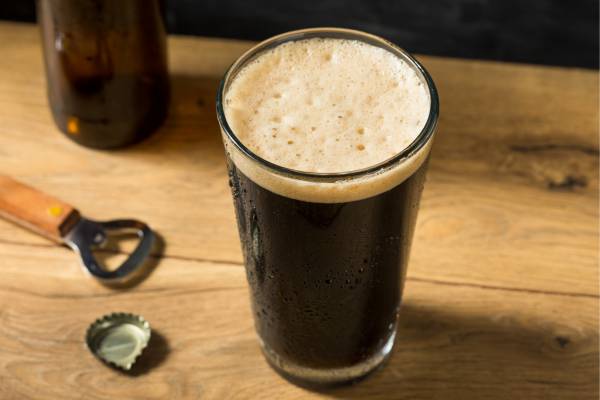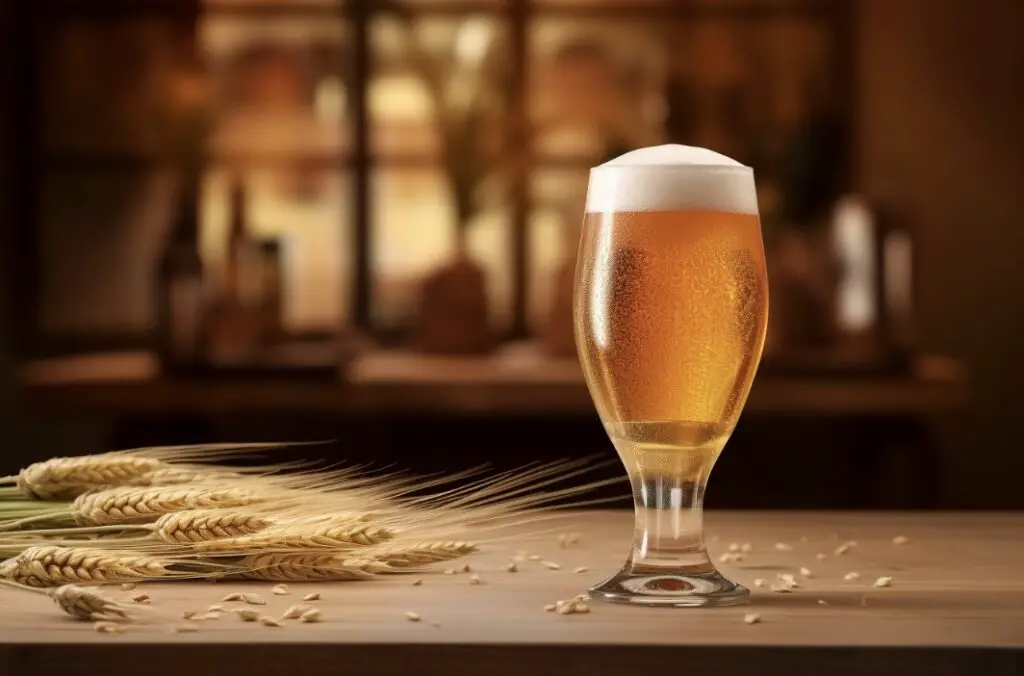As a brewer, I often find myself in conversations with fellow beer enthusiasts about the nuances between various beer styles. One question that frequently comes up is: what is the difference between a stout and a pilsner?
The main difference between a stout and a pilsner lies in the type of malt used, the brewing process, and the resulting flavor profile. Stouts are dark, rich, and often roasty, while pilsners are light, crisp, and clean.
In this blog post, I’ll dive deep into the distinctions between these two popular styles of beer, taking a closer look at their history, ingredients, brewing processes, and sensory characteristics.
A Brief History of Stout and Pilsner
Before we delve into the specific differences between stout and pilsner, it’s essential to understand their origins.
Stout
The history of the stout beer can be traced back to the 18th century in London, England. Initially, the term “stout” was used to describe any strong beer. However, over time, it became more closely associated with dark, robust porters. Eventually, the stout evolved into its own distinct style, separate from the porter.

Pilsner
Pilsner, on the other hand, was born in the Czech town of Plzeň in the early 19th century. The invention of modern pilsner is credited to Josef Groll, a Bavarian brewmaster who utilized the town’s soft water and the newly developed pale malt to create a bright, clear, and refreshing lager. The pilsner style quickly gained popularity and is now one of the most widely consumed beer types globally.

The Ingredients: Malt, Hops, Yeast, and Water
The primary ingredients in beer are malt, hops, yeast, and water. The specific type and proportion of these ingredients play a significant role in determining the final product’s flavor, aroma, and appearance.
Malt
Stouts and pilsners differ significantly in the type of malt used. Stouts typically utilize darker malts, such as chocolate or black malt, which impart a deep color, roasty flavors, and a rich mouthfeel. Pilsners, however, primarily use pale malts that produce a light, crisp body and a golden hue.
Hops
The hop varieties used in stouts and pilsners also contribute to their distinct flavor profiles. Stouts often feature English hop varieties, which provide a moderate bitterness and earthy, herbal notes. Pilsners generally incorporate noble hops, such as Saaz or Hallertau, which lend a delicate, floral aroma and a balanced bitterness.
Yeast
The yeast strains used in brewing stouts and pilsners differ as well. Stouts are typically brewed with ale yeast, which ferments at warmer temperatures and produces fruity, estery flavors. Pilsners, being a type of lager, are fermented with lager yeast at cooler temperatures, resulting in a clean, crisp profile with minimal fruity esters.
Water
Water chemistry can also play a role in the final beer’s character. Stouts are often brewed with water high in bicarbonates, which can accentuate the dark malt’s roastiness. Pilsners, conversely, are known for being brewed with soft water, which allows the delicate malt and hop flavors to shine through.
The Brewing Process
While the basic brewing process for a stout and a pilsner is similar, there are some key differences in technique that contribute to their divergent characteristics.
Mashing and Sparging
During the mashing and sparging process, the brewer extracts sugars from the malt to create the wort. Darker malts used in stouts require a slightly different approach, with some brewers opting for a lower mash temperature to avoid extracting too much astringency from the dark grains.
Boiling and Hop Additions
The boiling stage is where the brewer adds hops to the wort. Stouts typically have fewer hop additions, focusing more on bittering hops to balance the malt sweetness. Pilsners, however, often have multiple hop additions, including later additions for aroma and flavor.
Fermentation and Lagering
As mentioned earlier, stouts are brewed with ale yeast, while pilsners are brewed with lager yeast. The fermentation temperature is a crucial distinction, with stouts fermenting at warmer temperatures (around 65-68°F) and pilsners fermenting at cooler temperatures (around 50°F). Once primary fermentation is complete, pilsners undergo a lagering phase, during which the beer is stored at even colder temperatures (around 34°F) for several weeks. This lagering process contributes to the pilsner’s clean, crisp profile.
Appearance and Color
One of the most apparent differences between a stout and a pilsner is their appearance. Stouts are known for their dark, opaque color, ranging from deep brown to almost black. Pilsners, on the other hand, are characterized by their bright, golden hue and crystal-clear clarity.
Aroma and Flavor
The aroma and flavor profiles of stouts and pilsners are also quite distinct.
Stout
Stouts often showcase robust, roasty aromas, with notes of coffee, chocolate, and sometimes a hint of dark fruit. The flavor profile of a stout can vary depending on the specific style (e.g., dry stout, milk stout, oatmeal stout), but common characteristics include a rich, roasted malt backbone, moderate bitterness, and a full, creamy mouthfeel.
Pilsner
Pilsners, in contrast, exhibit delicate, floral hop aromas and a subtle, bready maltiness. The flavor is typically crisp and clean, with a light, biscuity malt character balanced by a moderate hop bitterness. Pilsners are known for their refreshing, easy-drinking quality and smooth, clean finish.
Alcohol Content
In general, stouts tend to have a higher alcohol content than pilsners, although this can vary widely depending on the specific style. Traditional dry stouts, like Guinness, typically have a moderate alcohol content (around 4-5% ABV), while imperial stouts can reach as high as 10% ABV or more. Pilsners, on the other hand, usually fall in the range of 4-6% ABV.
Food Pairings
Because of their contrasting flavor profiles, stouts and pilsners pair well with different types of food. Stouts are a natural match for hearty, savory dishes like grilled meats, stews, and rich chocolate desserts. Pilsners, with their crisp, clean flavors, complement lighter fare such as seafood, salads, and mild cheeses.
Conclusion
In conclusion, there are several key differences between stouts and pilsners, including:
1. Stouts originate from England, while pilsners come from the Czech Republic.
2. Stouts use darker malts, while pilsners use pale malts.
3. Stouts feature English hop varieties, while pilsners use noble hops.
4. Stouts are brewed with ale yeast, while pilsners are brewed with lager yeast.
5. Stouts have a dark, opaque appearance, while pilsners are bright and golden.
6. Stouts exhibit roasty, malty aromas and flavors, while pilsners showcase floral hops and bready maltiness.
7. Stouts have a higher alcohol content than pilsners, although this can vary depending on the specific style.
8. Stouts pair well with rich, savory dishes, while pilsners complement lighter fare.
9. Stouts are known for their full, creamy mouthfeel, while pilsners have a crisp, clean finish.
10. Stouts are fermented at warmer temperatures, while pilsners undergo a cold fermentation and lagering process.
Understanding the differences between these two popular beer styles can enhance your appreciation for the diverse world of brewing and help you make informed choices when selecting a beer to enjoy or pair with your next meal. Cheers!
FAQs
Is Bud Light a pilsner or a lager?
Bud Light is a lager.
Is Miller Lite a pilsner or a lager?
Miller Lite is a light lager.
What are the 3 major classifications of beer?
The three major classifications of beer are ale, lager, and hybrid/mixed styles.
Is Corona a lager or pilsner?
Corona is a lager.
Is Heineken A lager or a pilsner?
Heineken is a lager.
What makes a beer a pilsner?
A beer is classified as a pilsner if it is a light to medium-bodied lager that is crisp, clean, and refreshing, with a noticeable hop bitterness and a subdued malt sweetness. It is brewed using a specific type of yeast and a combination of malted barley and hops that give it a distinctive flavor and aroma.




